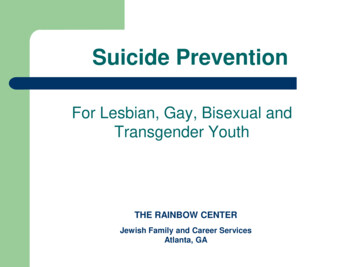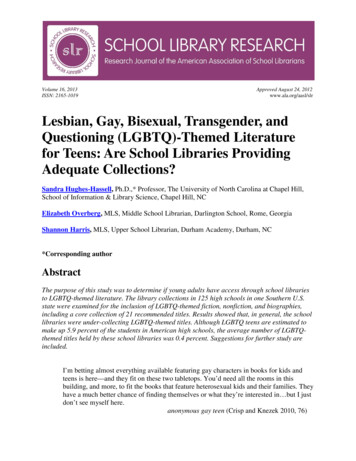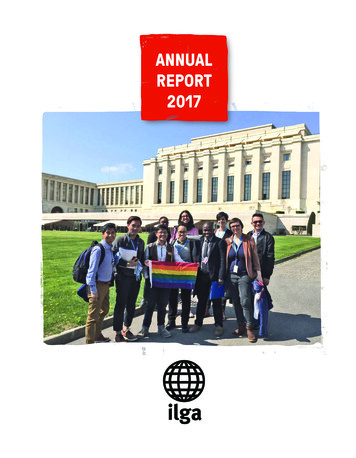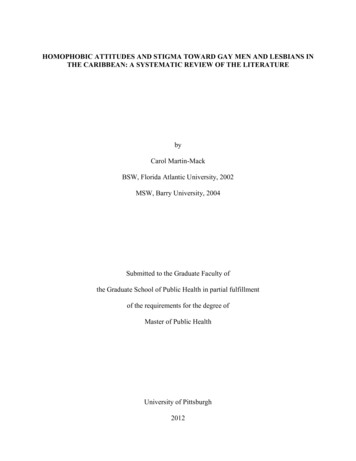
Transcription
Suicide PreventionFor Lesbian, Gay, Bisexual andTransgender YouthTHE RAINBOW CENTERJewish Family and Career ServicesAtlanta, GA
Stats on Youth Suicide Suicide is the 3rd leading cause of death in adolescents and youngadults (age 10-24). Males account for 82% of all suicides; however, women attemptsuicide 3 times more than men There are approximately 35,000 suicides a year The 2000 U.S. Census determined that 6% of the populationdisclosed being LGBT and 21% of the population is between theages of 10 and 24 From these numbers it can be inferred that 7,350 suicides a yearare youth suicides and of those suicides, close to 500 are confirmedLGBT youth. Another study indicates that 30% of the victims ofyouth suicide have issues with sexual identity (D’Augelli &Grossman, 2001).
Why LGBT Youth? Research indicates that lesbian, gay, bisexual and transgendered(LGBT) adolescents are three times more likely to report suicidalideation than non-LGBT youth, and two to seven times more likely toreport a suicide attempt. LGBT youth in rural communities are especially at risk due to theirisolation from other LGBT youth and the lack of competent mentalhealth resources (Goldfried, 2001). LGBT youth have more severe risk factors and fewer protectivefactors than heterosexual youth. For example, LGBT youth often lacka supportive family and a school environment free from harassment(DuRant, 1998; Fergusson et al, 1999; Garofalo et al, 1998;Remafedi, 1999; Russell & Joyner, 2001; Russell, 2003).
Key PointBeing gay in-and-of-itself is not the cause of theincreased prevalence of suicide in LGBT youth;the increased risk comes from the psychosocialdistress associated with being gay.
Risk Factors of Suicide1.2.3.4.5.6.7.Previous suicide attemptsHistory of mental disordersHistory of alcohol andsubstance abuseFamily or peer history ofsuicideHistory of childmaltreatmentFeelings of hopelessnessBullying and harassment8.9.10.11.12.13.(for the general population)Impulsive or aggressivetendenciesBarriers to accessing mentalhealth treatmentPhysical illnessEasy access to lethalmethodsUnwillingness to seek helpIsolation; a feeling of beingcut off from other peopleSource: Bossarte, R.M. (2007) “Adolescent Suicide in Appalachia and Rural Areas.”
Risk Factors for LGBT Youth To explain the high rate of suicide in LGBT youth, Kaplan and Sadock(2003) state:Universal features in suicidal adolescents are the inability tosynthesize solutions to problems and the lack of coping strategiesto deal with immediate stressors. Therefore, a narrow view of theoptions available to deal with recurrent family discord, rejection, orfailure contributes to a decision to commit suicide. For gay adolescents this is far more pronounced. The process of realizingthat one is gay and having to accept it is an immediate stressor and canactually narrow one's options further by taking away coping resources andlimiting support, such as friends and family (Goldfried, 2001; Safren &Heimberg, 1999; Paul et al., 2002; Nelson, 1997).
Risk Factors for LGBT Youth Numerous studies reported by Remafedi (1999) found that suicide attemptswere significantly associated with psychosocial stressors, including gendernonconformity, early awareness of being gay, victimization, lack of support,school dropout, family problems, acquaintances’ suicide attempts,homelessness, substance abuse, and other psychiatric disorders. Goldfried (2001) reported that one out of every three were verbally abused byfamily members, one out of ten were physically assaulted by a family member Gay adolescents who "come out" (disclose their sexuality) may experience greatfamily discord, rejection, and even failure from the disappointment they elicit(D'Augelli et al., 1998). One study involving 350 gay adolescents between the ages of 14 and 21reported that 54% made their first suicide attempt before “coming out,” 27%made the attempt during the same year they came out, and 19% made theattempt after coming out (D'Augelliet et al, 2001).
Implications for LGBT Youth These negative experiences can result in mood disorders, lower selfesteem, posttraumatic stress symptoms, substance abuse, and suicide. LGBT youth are also more likely to have consulted and mental healthprofessional, use recreational drugs, and participate in self-harmingbehaviors. Although homosexuality is a known risk factor for adolescent suicide,many physicians and other helping professionals fail to adequatelyemphasize this point. Therefore, important issues, like the prevalence of suicide among gayadolescents remain invisible to mainstream psychology, mainstreamhealthcare and the school system – all areas where LGBT youth mayseek out help.
Need for (School) Intervention In one study of 9th through 12th graders, 24% of gay/bisexual malesreported at-school victimization ten or more times per year as comparedwith 2.7% of their heterosexual counterparts, and 10.1% of lesbian/bisexualfemales compared with 1.1% of their female counterparts (Bontempo &D'Augelli, 2002). Logic proves that if the stressors LGBT youth face are found in theeducational system but support is made available to children in schools,these numbers of suicide attempts will drastically decrease. This two-pronged approach of addressing LGBT issues and suicideprevention through education will not only decrease risk factors and theprevalence of suicide among LGBT youth, but will also promote protectivefactors that will benefit all children in schools
Why Schools? Youth and teens spend the majority of time at their schools. Teens are especially good at hiding strong feelings from their families. Behavior that may be considered “a cry for help” often occurs atschool, rather than at home. Youth and Teens tend to talk more to their peers than to their parents. Youth and Teens see schools as a place to grow, question, anddevelop. Therefore, creating schools that are “safe spaces” forchildren is integral to their development.
Protective FactorsCultural and religious beliefsthat discourage suicide andsupport self-preservationinstincts1.Effective clinical care formental, physical and substanceabuse disorders2.Easy access to a variety ofclinical interventions andsupport for help- seekingACTION-ORIENTEDPROTECTIVE FACTORS:3.Family and community support9.Promote help-seeking behaviors4.Support from ongoing medicaland mental health carerelationships10.6.Skills in problem solving,conflict resolution, andnonviolent handling of disputesWork with leaders and decisionmakers in schools, healthcare,faith communities and the publicand private sectors to raiseawareness on suicideprevention7.Effective coping skills8. Address risk factors, methods forintervention, debunk myths andstereotypes, and erase barriersthat inhibit help-seeking behaviors
Safe Spaces A supportive community is considered a “safe space” that, whenreferring to children, always results in positive outcome. When safe spaces are created in classrooms: They become significantly more effective learning environments becausestudents are freed from putting energy into wondering if they are safe.Students become more focused on participating in class rather thanwondering if they can just be themselves.
The Safe Space Model The Safe Space model considers 5aspects that inhibit a classroom frombeing a “safe space” Fear – with voicing opinions and ideasSilence – due to fear; increasesinvisibilityUse of Energy – exertion of energy intrying to assess safetyPositive Self-Talk – used to feel saferand boost self esteem when afraidStereotyping – produces moreinternalized homophobic responsesBeing Guarded – for protection and selfpreservation
The Safe Space Model (cont’d)OutcomesDecrease Fear SilenceIncrease Not putting energytowards feeling safe Use of energy Peer Support Not being guarded anddefensive Need for positiveself-talk Power ofteacher Ability to be themselves Stereotyping Need to beguarded Level of commitment,genuineness, and activeparticipation in class Richer academicexperience
Take Steps Towards Cultural Competence Identify appropriate languageCounteract myths andstereotypesUnderstand the meaningbetween sexual orientation andgender identityChallenge homophobic remarksExamine your own biasesDon’t be surprised when ayouth “comes out”Don’t be afraid to ask questions It’s not “just a phase;” it’s not justan experimentRecognize same-sex attractionwithout attaching a label or“resolution” (they don’t need tobe “fixed”)Be aware that young people mayhave never heard anythingpositive about being LGBTQMay or may not be sexuallyactive; offer relevant information
Sources of Strength Health promotion and suicide preventionprogram Peer leaders conduct peer-to-peer activities Increase positive help-seeking behaviors,break down “codes of silence Increase partnerships with trusted adults Uses 8 protective factors to enhancecoping strategies Focus is on youth and adults www.sourcesofstrength.org
10 Things Professionals Can Do:1.2.3.4.5.6.7.Do not assumeheterosexualityGuarantee equalityCreate a safe environmentDiversify library and mediaholdingsProvide training for staffProvide appropriate healthcare and educationBe a role modelSource: GLSEN, “Ten Things Educators Can Do ” (New York: 2000)8.Provide support for students 9.Reassess the curriculum 10.Gay-Straight AlliancesOut for Equity Lesson PlansBroaden entertainment andextracurricular programs Jan- No name calling WeekApril - Day of SilenceJune – Pride MonthOctober – LGBT HistoryMonth/Coming Out Day
Tools for Suicide Prevention Immediate Response/Assessment to suicidal ideation is:“SLAP” however, the first response should always be the “GoodNeighbor” response which is simply: “Don’t do it!” Specific Details: Ask or determine if they have thought out specific details ofthe plan?Lethality of the plan: How lethal is it/how quickly could they die ifimplemented?Availability: Do they have access to the methods?Proximity: How close are people who could help (family, friends, etc)?Use “SLAP” to determine if the person needs help immediately. If help is notemergent, additional support can be put into place by the following methodsIs your work place prepared to manage suicidal behavior? It’s importantto have crisis plans in place in case a child is suicidal. School Readiness Survey
Organizations Can Also ADMINISTRATOR- ORIENTED: Hire, not fire, openly LGBT teachers and administrators (role models)Encourage teacher/student mentoring particularly for struggling LGBTyouthTrain teachers/administrators on how to deal with LGBT issues/conflicts,and suicidal ideation, diversity and cultural competenceMonitor students (text messaging, internet use, etc)PARENT-ORIENTED: Involve parents in supporting a community of inclusion with Open Housenights dedicated to issues of tolerance and diversityUse PTA meetings to raise awareness of LGBT issues in schools
Georgia’s Suicide Prevention Plan In 2001, Georgia’s Suicide Prevention Plan included eleven goals(action steps) to improve suicide prevention programs– Each goal highlights an opportunity for awareness, intervention andmethodology (AIM)The Plan was based on recommendations and information from:––––The Surgeon General’s Call to Action to Prevent Suicide in 1999The National Strategy for Suicide Prevention: Goals and Objectives forActionSuicide in Georgia: 2000, a state public health report, andInput from many concerned individuals and groups in Georgia
The Plan and The Safe Space Model Of the eleven action oriented goals, the Safe Space Model to suicideprevention in schools satisfies six goals; the majority of goals that theSafe Space Model does not satisfy are only applicable to adults orpeople with mental health illnesses–Awareness Goals:Goal 1: Promote AwarenessGoal 2: Develop SupportGoal 3: Reduce Stigma–Intervention Goals:Goal 4: Develop and Implement ProgramsGoal 6: Train and Deliver ServicesGoal 7: Develop and Promote Effective Practices
Sources and Resources Suicide Prevention Action Network ofGeorgia: http://www.span-ga.org/span/index.php?option com content&task category§ionid 4&id 18&Itemid 47 The Gay, Lesbian, and StraightEducation Network (GLSEN):www.glsen.com The National Center for CulturalCompetence: http://www11.georgetown.edu/research/gucchd/nccc/ Creating Safe Space for LGBTQ Youth,A Toolkit: afespace.pdf Beyond the Binary: A Toolkit for GenderIdentity Activism in .html Out for Equity:http://outforequity.spps.org/ GA Safe Schools Coalition:http://georgiasafeschoolscoalition.org/ The Gay, Lesbian, Bisexual, andTransgender Youth Support Project:www.hcsm.org/glys/glys.htm GLBT National Help Center: www.glnh.org The Human Rights Resource Center:www.hrusa.org Parents, Families and Friends of Lesbians& Gays (PFLAG): www.pflag.org Youth Pride: www.youthpride.org Maine Youth Suicide Prevention Program:http://www.maine.gov/suicide/ Healthy Children: www.healthychildren.org Suicide Prevention Resource Center:http://www.sprc.org/ The Trevor Project:http://www.thetrevorproject.org/
Articles CitedBontempo, D.E., & D’Augelli, A.R. (2002). Effects of at-school victimization and sexualorientaion on lesbian, gay or bisexual youths’ health risk behavior. Journal of AdolescentHealth, 30(5). 364-374.D’Augelli, A.R. (2002). Mental heath problems among lesbian, gay, and bisexual youths ages14 to 21. Clinical Child Psychology and Psychiatry, 7(3), 433-456.D’Augelli, A.R., & Grossman, A.H. (2001). Disclosure of sexual orientation, victimization, andmental health among lesbian, gay, and bisexual older adults. Journal of InterpersonalViolence, 16 (10), 1008-1027.D’Augelli, A.R., Hershberger, S.L., & Pilkington, N.W. (1998). Lesbian, gay, and bisexual youthand their families: disclosure of sexual orientation and its consequences. American Journalof Orthopsychiatry, 68 (3), 361-371.D’Augelli, A.R., Hershberger, S.L., & Pilkington, N.W. (2001). Suicidality patterns and sexualorientation-related factors among lesbian, gay, and bisexual youths. Suicide and LifeThreatening Behavior, 31 (3), 250-264.DuRant, R.H., Krowchuk, D.P., & Sinal, S.H. (1998). Victimization, use of violence, anddruguse at school among male adolescents who engage in same-sex sexual behavior.The Journal of Pediatrics, 133 (1), 113- 118.Fergusson, D., Horwood, L.J., & Beautrais, A.L. (1999). Is sexual orientation related to mentalhealth problems and suicidality in young people? Archives of General Psychiatry, 56 (10),876-880.
Articles Cited (cont’d)Garofalo, R., Wolf, R.C., Kessel, S., Palfrey, J., & DuRant, R.H. (1998). The associationbetween health risk behaviors and sexual orientation. Pediatrics, 101 (5), 895-902.Goldfried, M. (2001). Integrating gay, lesbian, and bisexual issues into mainstream psychology.American Psychologist, 56, 977-88.Kaplan, H., & Sadock, B. (2003). Kaplan and Sadock's Synopsis of Psychiatry BehavioralSciences/Clinical Psychiatry (9th edition) (pp. 1279-1281. Philadelphia, PA: LippincottWilliams & Wilkins.Nelson, J. (1997). Gay, lesbian, and bisexual adolescents: Providing esteem-enhancing care toa battered population. Nurse Practitioner, 22, 94-109.Paul, J., Catania, J., & Pollack, L., et al. (2002). Suicide attempts among gay and bisexual men:Lifetime prevalence and antecedents. American Journal of Public Health, 92, 1338-1345.Remafedi, G., Farow, J.A., & Deisher, R.W. (1991). Risk factors for attempted suicide in gayand bisexual youth. Pediatrcis, 87 (6), 869-875.Russell, S., & Joyner, K. (2001). Adolescent sexual orientation and suicide risk: Evidence froma national study. American Journal of Public Health, 91 (8), 1276-1281.Safren, S.A., & Heimberg, R.G. (1999). Depression, hopelessness, suicidality, and relatedfactors in sexual minority and heterosexual adolescents. Journal of Consulting and ClinicalPsychology, 67 (6), 859-866.
THANK YOU!
Suicide is the 3rd leading cause of death in adolescents and young adults (age 10-24). Males account for 82% of all suicides; however, women attempt suicide 3 times more than men There are approximately 35,000 suicides a year The 2000 U.S. Census determined that 6% of the population disc











